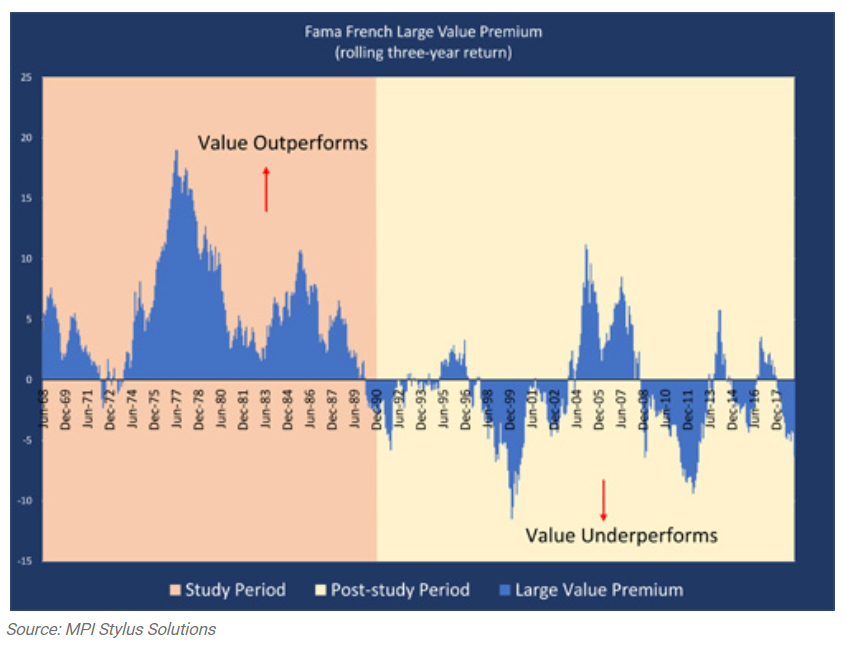After the sturdy efficiency run of progress versus worth investing lately, many buyers have began to query the validity of the latter funding model, notably after the newest few months. Worth shares underperformed when the markets have been on the best way down in March, and so they’re lagging different investments with the markets on the best way up.
By way of many discussions I’ve had with the diligent worth disciples on the market, I can see that their persistence is beginning to run skinny. The centerpieces of the worth argument are enticing valuations and imply reversion—the speculation that asset costs and returns will revert to their historic averages. But many market contributors are discovering it more and more tough to abdomen the disparity in efficiency between progress and worth investing, which continues to develop by the day, quarter, and 12 months. To the worth diehards, although, the reply is easy: imply reversion has labored prior to now, overcoming durations of volatility, and this market surroundings is not any totally different. They are saying persistence is the reply, as a result of the worth premium will at all times exist.
The Worth Premium Argument
The worth premium argument has been eternally linked to Eugene Fama and Kenneth French, two lecturers who printed a groundbreaking research in 1992 stating that worth and dimension of market capitalization play an element in describing variations in an organization’s returns. In response to this idea, Fama and French instructed that portfolios investing in smaller corporations and corporations with low price-to-book values ought to outperform a market-weighted portfolio over time. The aim of this strategy is to seize what are generally known as the “worth” and “small-cap” premiums.
“Worth” could be outlined because the ratio between an organization’s guide worth and market value. The worth premium refers to returns in extra of the market value. The small-cap premium refers back to the larger return anticipated from an organization with low market worth versus that of an organization with giant capitalization and excessive market worth.
Worth Versus Progress
The pink-shaded space within the determine beneath reveals the efficiency of the worth premium (with worth outperforming progress) over the research interval from 1963 to December 1990 on a rolling three-year foundation. Information from the submit–research interval of January 1991 till the current is proven within the yellow-shaded background.

Observe that there are two very totally different return patterns pre- and post-study. Within the pre-study interval, worth outperformed progress 92 % of the time, and this knowledge was the premise for the 1992 research’s findings. Within the post-study interval of the previous 30 years, nevertheless, progress outperformed worth 64 % of the time. The longest stretch of worth outperformance prior to now 30 years got here in the course of the financial and commodity growth of 2000 to 2008. In different years, the worth premium has been largely nonexistent.
Does the Worth Premium Nonetheless Exist?
In January 2020, Fama and French printed an replace of their work titled “The Worth Premium.” On this report, the 2 authors revisit the findings from their unique research, which was based mostly on practically 30 years of knowledge that clearly confirmed the existence of a giant worth premium. In it they acknowledge that worth premiums within the post-study interval are reasonably weak and do fall from the primary half of the research to the second. It’s additionally notable that different research have come out over time making related claims (Schwert, 2003; Linnainmaa and Roberts, 2018).
What can we take away from the information introduced by Fama and French? To me, it appears cheap to ask, if the roughly 30 years of pre-study knowledge was enough to conclude that the worth premium existed, is just not the 30-year post-study interval (throughout which worth clearly underperformed) sufficient time to counsel the worth premium has diminished or now not exists?
When contemplating this knowledge, buyers might want to query whether or not imply reversion ought to proceed to be a centerpiece within the value-growth debate. They may additionally ask whether or not strategically allocating portfolios to seize a seemingly diminishing premium is sensible. In response to the information, we have now just a few causes to think about why progress may grow to be the dominant asset class for a lot of buyers. When doing so, nevertheless, it’s essential to bear in mind the potential dangers of progress shares, which can be prone to large value swings.
All this makes worth versus progress an fascinating matter, which I’ll deal with additional in a future submit for this weblog. Within the meantime, should you’d like to interact in a dialog about worth versus progress, please remark within the field beneath. I’ll be joyful to share my ideas and perspective.
Editor’s Observe: The unique model of this text appeared on the Impartial Market Observer.



